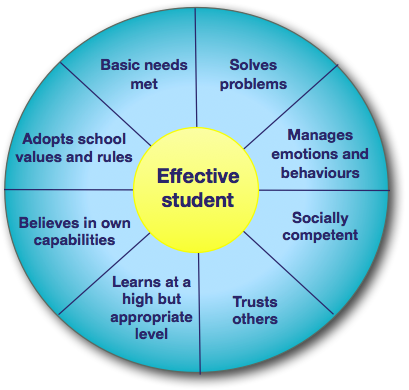
Promoting student wellbeing
October 28, 2012
Students are better able to manage their school day and learn effectively when they are healthy, feel safe, can regulate their feelings and emotions and are largely worry free. Linking individual student wellbeing and management with teaching and learning are on-going challenges for today’s classroom teachers.
The following eight factors can help build student wellbeing.

The goals of a whole-class or whole-school approach focussed on this student wellbeing model is to help build respectful relationships, resilience, and well-adjusted students who are able learn effectively.
Basic needs are met
In May of this year we published the Blog Foundations for building resilience, which detailed that a healthy lifestyle is integral to being resilient, without it children and adults will find it difficult to cope with life’s challenges. The four foundations for building resilience are:
- A set bedtime that allows for 8-12 hours of sleep each night.
- A healthy balanced diet.
- At least 60 minutes of moderate to vigorous exercise each day.
- Feeling safe.
Solves problems
A recent Australian study[1] revealed that the top two things children worry about are friends and family dying, and the environment. Other top worries include family issues, concerns about physical appearance, losing or keeping friends, homework pressures, the future, doing tests or assignments, pets dying, not having enough time to do things, and school.
All children worry sometimes. When children worry they generally focus on what will happen if things go wrong at a future event, such as failing a test or a parent dying. Some children also worry about what they have said or done in the past, for example arguing with a parent or sibling.
Worry that primes positive action, such as practising for a test or learning to cope with a challenging situation, is healthy. However, worry can become a problem when it is frequent or excessive or when it consumes all thoughts or overwhelms the child’s emotional resources.
- Consider implementing a short ‘debrief’ before school as a means of sorting out or allowing the ‘off loading’ of any problems from the previous day. The aim is to help find short-term solutions to issues before the school day begins. This 5 or 10 minutes is also important in establishing a quiet, calm and safe start to the school day. If the debrief is unsuccessful, teach short simple relaxation calming techniques such as taking three deep breaths, counting backwards slowly from 10, saying ‘relax, relax’ to self or getting a sip of water from their drink bottle or from the outside taps, before returning and starting the day in a designated ‘calm area’.
- Have a ‘suggestion box’, use email, or Edmodo, or similar intranet communication tool where students can write – ‘private’ or ‘share’ – most students find this really helpful to either meet privately to discuss their concerns or as a group such as during circle-time discussions.
- Acknowledge the child’s worries. Listen to the child’s concerns. What are they? Are they something you can assist with? Ask the child if they have discussed the concern with their parents or another trusted adult and, if they haven’t, encourage the child to talk to their parents or a senior staff member such as the welfare coordinator or the deputy or assistant principal.
Psych4Schools members see the ebooklet, Working with children who worry excessively, for a number of practical ideas about how to talk with students who worry excessively and strategies to use.
Murray Evely and Zoe Ganim, Psych4Schools Psychologists
Not a member? Join Psych4Schools now at: http://www.psych4schools.com.au/membership.html